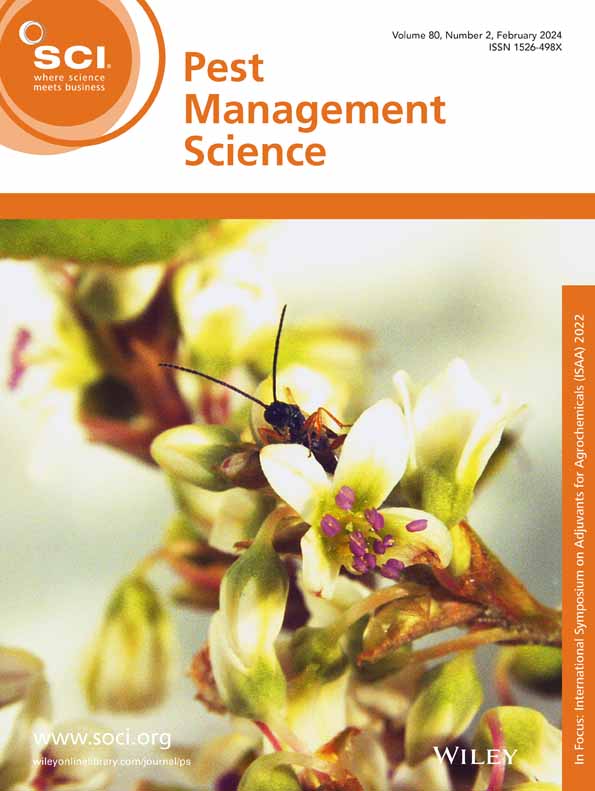Investigating non‐target site resistance to pyroxsulam in a glyphosate‐resistant Lolium rigidum population
Yalin Zeng, Min Liu, Hong Qian, Hui Zhao, Yuhang Fang, Qin Yu, Lianyang Bai, Lang Pan
求助PDF
{"title":"Investigating non‐target site resistance to pyroxsulam in a glyphosate‐resistant Lolium rigidum population","authors":"Yalin Zeng, Min Liu, Hong Qian, Hui Zhao, Yuhang Fang, Qin Yu, Lianyang Bai, Lang Pan","doi":"10.1002/ps.8636","DOIUrl":null,"url":null,"abstract":"BACKGROUNDResistance to multiple herbicides is common in <jats:italic>Lolium rigidum</jats:italic>. Here, resistance to acetolactate synthase (ALS)‐ and susceptibility to acetyl‐CoA carboxylase (ACCase)‐inhibiting herbicides was confirmed in a glyphosate‐resistant <jats:italic>L. rigidum</jats:italic> population (NLR70) from Australia and the mechanisms of pyroxsulam resistance were examined.RESULTSNo ALS target‐site mutations nor gene overexpression were detected. Cytochrome P450 monooxygenase (P450) and glutathione S‐transferase (GST) inhibitors (indicators of some certain P450s or GSTs) did not significantly affect the resistance to pyroxsulam. Nevertheless, HPLC analysis showed that plants of the NLR70 population metabolized pyroxsulam faster than plants of the herbicide‐susceptible population (SVLR1). RNA sequencing analysis and RT‐qPCR validation confirmed that four P450s (<jats:italic>CYP709B2, CYP72A14, CYP89A2, CYP94B3</jats:italic>), one GT <jats:italic>(UGT79)</jats:italic>, and one ABC transporter (<jats:italic>ABCG41</jats:italic>) genes were constitutively upregulated in NLR70 plants.CONCLUSIONThis study demonstrates that the glyphosate‐resistant <jats:italic>L. rigidum</jats:italic> population (NLR70) also exhibits resistance to pyroxsulam and identifies six candidate genes associated with non‐target site resistance to pyroxsulam. © 2025 Society of Chemical Industry.","PeriodicalId":218,"journal":{"name":"Pest Management Science","volume":"14 1","pages":""},"PeriodicalIF":3.8000,"publicationDate":"2025-01-11","publicationTypes":"Journal Article","fieldsOfStudy":null,"isOpenAccess":false,"openAccessPdf":"","citationCount":"0","resultStr":null,"platform":"Semanticscholar","paperid":null,"PeriodicalName":"Pest Management Science","FirstCategoryId":"97","ListUrlMain":"https://doi.org/10.1002/ps.8636","RegionNum":1,"RegionCategory":"农林科学","ArticlePicture":[],"TitleCN":null,"AbstractTextCN":null,"PMCID":null,"EPubDate":"","PubModel":"","JCR":"Q1","JCRName":"AGRONOMY","Score":null,"Total":0}
引用次数: 0
引用
批量引用
在一个草甘膦抗性稻瘟病菌群体中研究非靶点对苯妥胺的抗性
背景黑麦草对多种除草剂的抗性是普遍存在的。本研究证实了一个来自澳大利亚的草甘膦抗性L. rigidum群体(NLR70)对乙酰乳酸合酶(ALS)具有抗性,对乙酰辅酶a羧化酶(ACCase)抑制剂具有敏感性,并探讨了其对pyroxsulam的抗性机制。结果未发现ALS靶位突变和基因过表达。细胞色素P450单加氧酶(P450)和谷胱甘肽S转移酶(GST)抑制剂(某些P450或GST的指标)对pyroxsulam的抗性没有显著影响。然而,高效液相色谱分析表明,NLR70群体的植物比除草剂敏感群体(SVLR1)的植物代谢得更快。RNA测序分析和RT‐qPCR验证证实,4个p450基因(CYP709B2、CYP72A14、CYP89A2、CYP94B3)、1个GT基因(UGT79)和1个ABC转运蛋白基因(ABCG41)在NLR70植物中组成性上调。结论本研究表明,耐草甘膦L. rigum群体(NLR70)也表现出对pyroxsulam的抗性,并鉴定出6个与对pyroxsulam非靶位抗性相关的候选基因。©2025化学工业协会。
本文章由计算机程序翻译,如有差异,请以英文原文为准。


